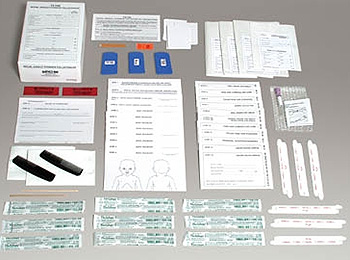5 Common Myths About Sexual Assault You Probably Believe

The most fortunate of us learned everything we know about sexual assault from two sources: Hollywood, and scandalous news stories that usually focus on the accused (since it usually takes a celebrity perpetrator to make headlines). Shockingly, they do not always paint an accurate picture of reality.
We're thus left with a series of misconceptions and biases that range from merely wrong to horrific. To set the record straight, we talked to "Amanda," an RN and Sexual Assault Forensic Examiner ("SAFE"). Who are you going to believe, her, or a show in which the crime is being investigated by Ice-T?
Myth: A Rape Victim Always Has Some Kind Of Injury
According to Oscar-winning movies like Monster and Boys Don't Cry, rape victims will always be bruised and bloody (after all, it was an assault, wasn't it?). In a weird case of pop culture influencing itself, the villain of Gone Girl gets it into her head that in order to convincingly fake a sexual assault, she must go the extra mile and simulate the event with a goddamned wine bottle. Conclusion: If a woman has truly been assaulted, there'll be damage, even if it takes a doctor and a special exam to find it.
This, however, is not true -- an assault might not leave any injuries at all (we're often talking about a part of the body designed to push out a baby, for Pete's sake). That's a good thing in theory, but it's something Amanda constantly has to explain to people.

For example, these people.
"This is a huge prosecutorial hurdle to overcome," she says. "It's one of those details that you walk into court expecting to have to testify to, and you tell the prosecutor to ask that question specifically, so I can tell the jury that no visible injury does not mean there was no trauma." In fact, she points out, vaginal injury is just as likely to occur as a result of consensual sex, so even when there are injuries, they aren't evidence of a crime.
Meanwhile, the injuries that victims should worry about are ones you almost never see on TV. "Interesting fact: If an assault, sexual or otherwise, involves strangulation, it is automatically deemed a felony offense," Amanda says. That's because even brief strangulation can lead to damage you don't even notice until much later. "When a person loses consciousness from strangulation, this is often caused by micro strokes in the brain," she explains. "These tiny strokes can often only be detected on CT or MRI, and can be deadly. Even if they don't kill you today, the cumulative effect is that of a traumatic brain injury and can lead to lifelong deficits."

Procedural crime dramas don't really brace you for that part.
That's why Amanda and other specially trained medical professionals always check for strangulation, even if the victim is pretty sure they would remember that kind of thing. Often they don't, Amanda says, and often the only sign is a thumbprint bruise behind the earlobe or broken blood vessels in the eyes, ears, or mouth. In other words, a lot of places you can't see on yourself. This is one reason Amanda is adamant about victims going to the hospital afterward, even if they think they escaped the attack unharmed.
Wait, you didn't know that many victims avoid going to the hospital afterward? They sure do, and it's because a lot of them believe ...
Myth: Getting Examined Afterward Is Almost As Bad As The Assault
This is the dreaded "rape kit" you've seen in a million shows, the exam a victim gets after a sexual assault. Here's where popular culture tries to portray this in a way that drives home how unpleasant and invasive it is (to help us sympathize with victims, which is nice) but in the process, winds up scaring many victims away.

The fact that it's a big box of mysterious swabs, containers, and fine-tooth combs doesn't do much to ease the mind.
You can probably picture it at this point. "A bruised, weeping girl reclines on a cold exam table with her legs in stirrups," Amanda guesses. "The doctor comes out from the sheet covering her genitals and tells the detective standing beside him about the evidence he found." The fact that the detective may or may not be Ice-T doesn't help. One marathon of crime dramas is enough to give anyone a phobia of both police and doctors.
To wit: In one episode of Law & Order, Officer Jayne-Mansfield's-Daughter informs a rape victim at a hospital that she must have a rape kit whether she likes it or not, literally chases her down when she starts to run, then casually hurls a "don't take a shower in case you change your mind" at her retreating figure. Meanwhile, the doctor seems more concerned with exactly how drunk the victim may or may not have been than the shards of glass he removed from her body.
No doubt, shitty cops and doctors do exist (we'll get to that later), but people don't tend to go into this specialty with the intention of torturing victims. Here's how it goes where Amanda works: "The patient is taken immediately back to a room and the SAFE nurse is contacted to come in and take the case," Amanda says. "I tell them that SAFE means I am specially trained to work with survivors of traumas and assaults like they have been through, and there is nothing that they can tell me that will shock me."
What follows is a pretty routine check-up. "I ask about how she is doing now. Any discomfort? We talk about each body part, and pain in your head, neck, shoulders, all the way down. Then we check in. I ask how she is doing and if she's ready to talk about what happened. When she is ready I start writing. Verbatim, everything she says gets written exactly. This report is what directs my care. Based on what they tell me, I know where to look for injuries as well as where to collect evidence. I also know how to make them more comfortable: For example if there was no contact with her mouth I can now get her something to eat or drink without risking losing evidence."

It's a rare person who wouldn't rather have a cup of tea than a cotton swab.
"Depending on what she would like to do, we proceed," Amanda continues. "I have her stand on a clean sheet and disrobe behind a curtain I hold up. Each article of clothing is separated to be boxed up for evidence. She changes into a gown and sits on the bed. Then I begin the head-to-toe exam ... I ask the patient if there is any discomfort along the way, and if I see any injuries, I will ask what happened. We can take photos of injuries for later use, and will swab areas where evidence may be, based on the story.
"The final step of the exam is the dreaded genital exam. If she is not comfortable, we skip this, but most women are okay with it by this point because we have built a good rapport. She positions herself just like we are doing a pap smear, a speculum is inserted, I check the tissue for trauma while collecting samples -- and we are done."

So not exactly a relaxing trip to the spa, but also not a vivisection under the withering glare of Ice-T that TV would have you believe.
Were you surprised that the victim had the right to decline parts of the procedure? "From the moment you walk into my ED, you are in charge," Amanda says. "My job is to give you back control of your body and your choices. If you just want STD and pregnancy prevention medications, that's all we have to do. If you want a head-to-toe exam to check for injuries, you got it. Evidence collection and police reporting? I will make it happen for you. You are in charge."
The exam also doesn't mean the victim is pressing charges -- getting a rape kit doesn't trigger an investigation. Police can be given the kit anonymously and will hold it for 90 days while the victim decides. So please, if this happens to you, go to the hospital.

Particularly since with pregnancy and STI prevention, time is a factor.
Myth: Assaults Leave Victims In An Obvious State Of Terror/Panic
It seems weird that someone wouldn't remember getting strangled, right? In fact, you'd think every second of an attack like this would be permanently seared onto the insides of their eyelids. When TV cops interview a freshly assaulted victim, they always behave the same way -- they're emotional, sometimes actively panic-attacking, but you can bet they can recall every vivid detail. Real life, as usual, is weirder.
"When a brain is going through a severe traumatic stress, the information is entered into the memory in a unique way, a primal way," Amanda says. "You remember smells and sounds more strongly than conversations and social cues. The 'how' and 'why' becomes fuzzy while other facts ring through crystal clear. When the memory is accessed later, in a calm state, the memory may be no longer chronological, more sensory-focused than sensible, or even blank altogether."

Unfortunately, having the stink of your rapists' body spray forever burned into your memory isn't the most helpful detail.
So, when some of those details turn out to be incorrect later, it's easy to come to the conclusion that the victim is making it all up. "Listening to a victim tell a story that keeps changing, or she can't remember whether the assailant was black, white, shirtless, masked or otherwise, seems to like a good reason for skepticism."
As for all those dramatic tears, it happens in some cases, in others the victim seems cold or even detached. This is partly because of the unique way every human brain process trauma, and partly due to the fact that you're actually not seeing them in the immediate aftermath. "he vast majority of my patients come 12, 24, or even 72 hours post assault -- and even then not without cajoling from loved ones, therapists, or college R.A.s." In that time, they've probably gone to class or work, even hung out with friends -- the world keeps turning no matter what trauma is screaming through our heads.

Putting your head in your hands and pretending nothing happened might not be a great choice, but it sure is a popular one.
"One woman told me about how she was walking at night on her campus," says Amanda. "She was a tall, strong athlete that no one would have labeled 'damsel in distress.' She said she felt someone walking behind her and the hairs went up on her neck, she picked up the pace. When she looked back, there was actually three men following her. She felt sweaty and nervous but kept her walking pace, believing that her alarm system was overreacting. The men began walking faster and closing in and she panicked. Running across the quad she looked back and saw there were five men chasing her 'Like a pack of wild animals. And I was prey.' I will always remember that description. she spoke flatly and coldly about this emotional moment."
Unfortunately for victims, nearly everyone they encounter -- from police, to juries, to friends -- watched the same shows and movies you did. And let's face it: Actresses don't win awards by playing crime victims as cold, detached, and confused.

If it doesn't seem like movies could possibly affect real juries that much, think again.
Myth: Everyone Is Going to Treat Your Assault As The Emergency It Clearly Is
When you go to the Emergency Room, particularly with an especially heinous emergency, you probably expect it to be treated like an emergency, since that's word everyone keeps using. The reality is that you may find your suffering is not that high a priority. "We have a trauma hospital right down the street that has a terrible attitude toward domestic violence and sexual assault patients," Amanda says. "I personally know of a case where a sexual assault survivor was brought to that hospital by police for a pretty bad attack. Because she was not a high-risk/trauma patient like a gunshot wound or a stroke, she sat in the waiting room for six hours! Can you imagine?"
Amanda says the main reason about half of all sexual assault victims report being treated poorly by healthcare professionals is under-staffing and under-training. See, although all RNs are trained in the basics of treating sexual assault survivors, many hospitals do not have specially trained sexual-assault examiners like Amanda. What can be reasonably taken as insensitivity may just be a lack of time or knowledge.

Turns out most nurses aren't exactly thrilled to dig into the details of a sexual assault either.
"Rape survivors require caregivers to have understanding about trauma reactions, patience with psychiatric hurdles, and a strong grip on their own biases and issues," she says. "In the fast-paced ER, providers may not be in a place to provide that care." So yeah, it's a real coin flip -- you might get someone like Amanda, or you might get some harried general ER nurse who's actively double-fisting cardiac arrests after 18 hours on her feet.
Even if you luck out in the waiting and examination rooms, there's still room for injustice on the way out, and we're not talking about the police. (Anymore. Or yet.) Writer Elyse Anders recently made headlines when she furiously tweeted a photo of the collections letter for her rape kit. That's right: They billed her for getting assaulted. That's understandably infuriating, and it's understandable that this would scare victims away from obtaining care. It's a freaking tornado of understandability. But there's a way around that, too: it's actually illegal. It turns out that the 13 states where victims had been held financially responsible were abusing loopholes that are quickly being closed. The most frequent offenders, Louisiana and Illinois, both passed laws against it in 2015.

This is about as shitty as it gets, but don't start dropping F-bombs at your screen quite yet. We saved the worst for last.
When everyone is following the law, Amanda says, the government actually pays for victims' medical services. "When a person is convicted of a crime against another person involving fines, the money goes into the victims' compensation fund," she explains. "This fund pays for medical and mental health care, lost wages, and other costs incurred for victims." Of course, you can't discount the dickery of individual hospitals (they can wind up eating some costs, and may not be happy about it) but making enough of a stink about how they're, you know, breaking the goddamn law goes a long way toward resolving the problem -- as eventually happened in Anders' case.
Myth: When You Get A Rape Kit, Someone Is Going To Actually Do Something With It
The other side of the Law & Order coin of bullshit is the idea that assaults occur, get investigated, and get prosecuted in no more than an hour minus commercial breaks. In reality, an estimated 400,000 rape kits are just sitting around untouched in evidence lockers around the country. Some of them go back decades.

OK: Now you can drop those F-bombs.
You've probably seen activists talking about this (there was even a Law & Order: SVU episode about it). According to Amanda, though, that problem can't be solved with demands and petitions. "A kit is processed at the request of the district attorney's office when they are going ahead with prosecution. If there is any question as to whether the DA thinks the case will be feasibly winnable, the kit will go untouched. This is an issue of resources. The DA cannot prosecute every case because the vast majority of cases are 'He Said, She Said,' have drugs or alcohol involved, or could be perceived as questionable by a jury (e.g. 'I was raped by my husband or ex-boyfriend')."
It's a catch-22 that circles forever back around to shitty attitudes about rape -- you can't convince a jury if you don't have hard evidence, and you can't get hard evidence unless you know you can convince a jury.

Which might be why the incarceration rate for rapists is a fucking disgrace.
"The scary thing is that in places where kits have been processed en masse, there has been a disturbing trend of evidence of serial rapists' DNA on multiple kits," she continues. "These perpetrators would have continued to go unidentified, were it not for the evidence telling a different story."
Amanda emphasizes that this doesn't mean having a post-assault exam is useless -- it might make it even more important. "A kit may never get processed, a case may never be prosecuted, and an assailant may never face justice -- but my patient will have been heard, been validated and supported through one of the worst experiences of their life," she says. "I cannot tell you how many exams begin with a girl bundled in clothes and jackets and blankets in the fetal position and ended with them asking me, 'Thank you so much for taking care of me. This is not at all what I had expected. Can I give you a hug?' And we do."
Let's clear some more of the air about sexual assault in 6 Realities Of Life When You're Raped By A Celebrity and 8 Ways the Legal System Screws Rape Victims (Like Me).
Have a story to share with Cracked? Email us here.
Subscribe to our YouTube channel, and check out The Worst Police Sketch Artist Ever, and other videos you won't see on the site!
Follow us on Facebook, and we'll follow you everywhere.